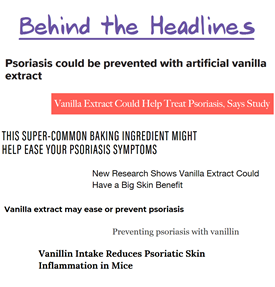19 December 2017
Behind the Headlines - Could Vanilla Extract Help Treat Psoriasis?
We take a closer look at recent reports in the media.
It seems that vanilla has been the flavour of the month, with many news outlets proclaiming that vanilla could treat or prevent psoriasis. These claims have been based on a study that has been published recently in the Journal of Agricultural and Food Chemistry. The Psoriasis Association has not funded, and is not in any way associated with, this research.
In this study, the authors looked at the effect of vanillin (the key chemical component of vanilla flavour) on a mouse model of psoriasis. This model uses imiquimod, a strong immune activator, to induce a psoriasis-like skin condition in the mice. Mice treated with imiquimod display many similarities to plaque psoriasis in humans, both in the appearance and underlying immune mechanisms. The authors found that consumption of vanillin had a number of positive effects on the mice. It reduced the thickness of the skin and the number of immune cells invading the skin, as well as decreasing the amount of the cytokines IL-17A and IL-23, which are key activators in plaque psoriasis.
These results are really positive and demonstrate an exciting new area of psoriasis research. However, before rushing out to buy some vanilla essence, it’s always important to look at the conclusions of the study within the context of how the results were found:
1. How reliable are the results?
This study was published in a peer-reviewed journal, which means that other scientists in the same field think that the research methods are robust and the conclusions that have been drawn are supported by the results.
To our knowledge, this is the first study looking at the effect of vanillin on a psoriasis model, which means that this area of research is still in a very early stage. Though promising, we will have to wait to see if the results can be replicated by other research groups
2. How was the research funded?
When assessing research, it’s often a good idea to be slightly cynical and take a look at who funded the research or whether the authors have any conflicts of interest. Everyone is susceptible to unconscious bias and scientists are no exception. This is not to say that the results of a particular study will be unreliable, but just something to bear in mind when reading about research, particularly if the results of a study are beneficial to the funder or the authors.
Funding or conflict of interest should be clearly stated in the original research paper and a link to the original paper should be found in any media articles. Some papers are open-access, where anyone can read them but others have to be paid for before you can read the whole article. In this case it’s the latter, however, you can still read the summary (also called the ‘abstract’) here. Unfortunately, the funder is not mentioned with this abstract.
3. How applicable is this to me?
First thing to note is that this study was carried out in mice with a psoriasis-like skin condition. Whilst mouse models are excellent for early research, not all discoveries are translatable to humans and we currently have no knowledge of how effective, or even safe, vanillin will be to treat psoriasis in humans.
Secondly, this study was conducted over a fairly short period of time. Mice were only fed vanillin for 7 days and so other, longer, studies will be needed to assess the long-term safety and efficiency of vanillin as a potential treatment. Not all chemicals can be tolerated long term by all species, indeed the National Institute of Health in America found that rats fed a diet containing 64 mg/kg vanillin everyday for 10 weeks showed reduced growth and damage in multiple organs.
Lastly, the authors state that the mice were fed 100mg of vanillin per kg. As the average laboratory mouse weighs 20g, this equates to 2mg of vanillin per day, which doesn’t sound too bad. However, the average European human weighs 70.8 Kg, which would mean consuming 7.08 g of vanillin daily.
To put this into context, an average recipe for 30 vanilla biscuits uses 1 teaspoon of vanilla extract. In the US, pure vanilla extract contains 100g of vanilla bean in each litre of extract, which equals 0.5g of bean extract in each 5ml teaspoon. However, only 2% of each bean is vanillin. This means that in the 30 biscuits there is a tiny 0.01g of vanillin, therefore to consume 7.08 g you would need to eat over 21,000 biscuits a day! So although there’s no harm in indulging in the odd sweet treat, it’s certainly worth taking the media’s stance on this research with a pinch of salt - or should that be sugar?
For more information, or for a list of resources used in producing this article, please contact the Psoriasis Association.
